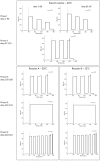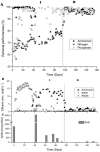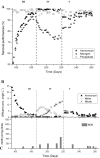Nitrogen removal over nitrite by aeration control in aerobic granular sludge sequencing batch reactors
- PMID: 25006970
- PMCID: PMC4113855
- DOI: 10.3390/ijerph110706955
Nitrogen removal over nitrite by aeration control in aerobic granular sludge sequencing batch reactors
Abstract
This study investigated the potential of aeration control for the achievement of N-removal over nitrite with aerobic granular sludge in sequencing batch reactors. N-removal over nitrite requires less COD, which is particularly interesting if COD is the limiting parameter for nutrient removal. The nutrient removal performances for COD, N and P have been analyzed as well as the concentration of nitrite-oxidizing bacteria in the granular sludge. Aeration phase length control combined with intermittent aeration or alternate high-low DO, has proven to be an efficient way to reduce the nitrite-oxidizing bacteria population and hence achieve N-removal over nitrite. N-removal efficiencies of up to 95% were achieved for an influent wastewater with COD:N:P ratios of 20:2.5:1. The total N-removal rate was 0.18 kgN·m-3·d-1. With N-removal over nitrate the N-removal was only 74%. At 20 °C, the nitrite-oxidizing bacteria concentration decreased by over 95% in 60 days and it was possible to switch from N-removal over nitrite to N-removal over nitrate and back again. At 15 °C, the nitrite-oxidizing bacteria concentration decreased too but less, and nitrite oxidation could not be completely suppressed. However, the combination of aeration phase length control and high-low DO was also at 15 °C successful to maintain the nitrite pathway despite the fact that the maximum growth rate of nitrite-oxidizing bacteria at temperatures below 20 °C is in general higher than the one of ammonium-oxidizing bacteria.
Figures








References
-
- Zhang Z., Zhou J., Wang J., Guo H., Tong J. Integration of nitrification and denitrifying dephosphatation in airlift loop sequencing batch biofilm reactor. Process. Biochem. 2006;41:599–608. doi: 10.1016/j.procbio.2005.08.005. - DOI
-
- Ekama G.A., Wentzel M.C. Difficulties and developments in biological nutrient removal technology and modelling. Water Sci. Technol. 1999;39:1–11. doi: 10.1016/S0273-1223(99)00117-1. - DOI
Publication types
MeSH terms
Substances
LinkOut - more resources
Full Text Sources
Other Literature Sources
Molecular Biology Databases

